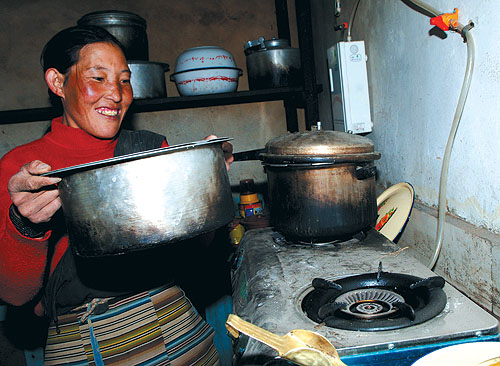|
 Mash gas has been adopted by many farmers and herders in Tibet for cooking.
Mash gas has been adopted by many farmers and herders in Tibet for cooking.
The Qinghai-Tibet Plateau, where the numerous natural solid reservoirs formed by glaciers are found, is the main source of dozens of rivers of China and neighboring countries such as the Yangtze River, Yellow River and Lancangjiang [Mekong] River. The plateau is home to many rare species, wetlands with the highest average attitude and diversified natural sights, all of important and even unique ecological value in the world.
In order to strengthen the work of ecological construction and environmental protection, the government of the TAR issued the Opinions of the People's Government of the Tibet Autonomous Region on Implementing the Decisions of the State Council Concerning Strengthening Environmental Protection with Scientific Outlook on Development. It held the Tibet Environmental Protection Conference and On-the-Spot Meeting on Ecological Environment Protection and Construction, made closer contact with the related departments of the State and actively formulated the Program on the Protection and Construction of the State Ecological Safe Shelter Zone on the Tibet Plateau. Tibet also actively worked to reduce the pollutant emission and completed the Plan on Comprehensive Work of Energy Savings and Pollutant Emission Reduction in the Tibet Autonomous Region. The region signed responsibility documents on key pollutants control during the period of the 11th Five-Year Plan with each prefecture or city to ensure the discharge of pollutants was contained within a specified range. The electricity consumption per 10,000 Yuan was some 500 kWh, lower than the national average level.
In 2007, the TAR people's government issued the Opinions on Decisions Concerning Strengthening Environmental Protection, which contained a decision to build a State ecological safety barrier on the Tibet Plateau, aiming to keep and improve environmental quality, enhance the sustainable development capability and guarantee people's health. Efforts will be made to control the emissions of COD (chemical oxygen demand) and SO2 (sulfur dioxide) in the whole region below the State-specified index by the end of 2010.
Tibet further conducted the special environmental protection action of "punishing the illegal pollutant-discharging enterprises to guarantee the health of mass people", sending more than 1,600 person times to investigate 134 farm product producing bases and food processing enterprises and 81 key enterprises and strictly supervised 50 environmental issues. Meanwhile, cross-inspection on environmental protection was carried out for the first time within the region, covering 44 counties in six prefectures and cities, which accounted for 59 percent of the total 74 counties. Meanwhile, Tibet conducted the second land survey. Currently, the work on environmental protection and construction as well as energy savings and reduction of pollutant emission runs in a standard and scientific way.
In 2007, a total of 480.84 million Yuan was spent on environmental protection, up 29.52 percent over the previous year. In 2008, emphasis will also be given on ecological construction and environmental protection. A fund of 100 million Yuan will be used for ecological compensation; a sum of 40 million Yuan as subsidy for forestation in key areas; and a total of 24.2 million Yuan for methane gas production with a view to building methane-generating pits for 30,000 households among farmers and herders.
In recent years, Tibet has strictly implemented an environment access system, forbidding the construction of enterprises with high energy consumption and pollution. It also actively carries out the project of replacing the firewood with solar energy and methane. In 2007, some 25,000 farming and herding households used clean energy, keeping the air quality of the region in good condition. So far, no accident regarding environmental pollution has happened in Tibet. It basically maintains the original natural state, being one of the areas with best environmental quality in the world.
(China's Tibet Facts and Figures 2008) |
